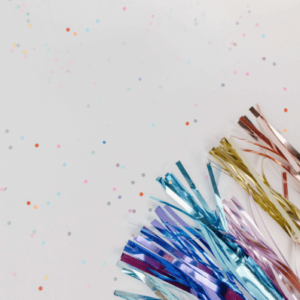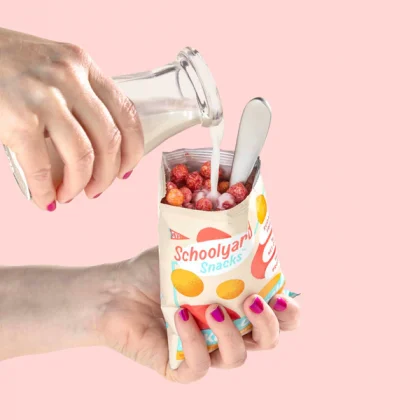If there’s a common theme among the DTC upstart brands trying to take over the cereal market, it’s an appeal to the child living inside adults.
Cartoons, lots of flavor, and targeting health-conscious consumers are all part of the playbook Schoolyard Snacks is running. This puts them squarely up against Magic Spoon, which we previously analyzed.
But while both brands are targeting the same consumers, how they’ve gone about it is different. So grab another helping and let’s take a closer look at Schoolyard Snacks.
What Schoolyard snacks Sells
Schoolyard Snacks primarily sells low-carb, keto cereal but has recently expanded its product line to include cheese puffs and cookies. For the cookies, they partnered with a company called Nunbelievable. Currently, cereal is still their biggest seller and main focus area.
The founders market themselves as ‘two big kids who never grew up’ and the idea behind their brand is that they’ve taken the timeless childhood comfort foods we all know and love and made a “guilt-free” version: low carb, high protein, and no sugar.
Their cereals are encased in vintage, nostalgic packaging and come in classic flavors: fruity, peanut butter, cocoa, and cinnamon. But unlike the cereals of our past, Schoolyard Snacks has all of the flavor without the added sugar.
The cereal is sold in individual, single-serve bags (for portion control, perhaps?) and are bundled in one or two flavors. Customers can make a single purchase or subscribe and save an additional 20%.
As far as the taste, My kids (ages 5 and 3) love both flavors. I was shocked.
I also liked both – I prefer the peanut butter over the cocoa, mostly because I don’t typically go for sweet breakfast foods. I’m usually not a huge fan of single-serve packaging, but again with kids, it’s always nice to be able to grab a couple for the road.
The Market Schoolyard snacks is Selling Into
Schoolyard Snacks is in the food and beverage market within eCommerce. This market is about 6% of the eCommerce retail market, according to eMarketer. According to Statista, the market is worth about $20 billion per year in the United States.
It’s my belief that Schoolyard Snacks is primarily targeting millennials between the ages of 25-40, based on co-founder Helen Guo’s commentary on building a product that recreates healthy versions of the cereals and snacks she grew up with (Guo is in her late 20s). They market directly to this group by promising ‘old school snacks made a new way’. The new way being zero sugar, low carb, and high protein.
They lean heavily on the nostalgia angle with their vintage packaging and classic flavors of the past – seemingly referencing childhood favorites Cap’n Crunch, Fruity Pebbles, and Cocoa Puffs.

Who they’re up against
While they’re up against cereal giants Kellog’s and General Mills, Schoolyard Snacks’ direct competitors are fellow upstart DTC brands Magic Spoon and OffLimits. Both brands appear to be targeting the exact same demographic as Schoolyard Snacks, leaning heavily into the childhood nostalgia that millennials connect with.
To take over the #1 spot in the DTC cereal world, Schoolyard Snacks not only relies on its aggressive marketing strategy but also on the quality of its product. They’ve proudly declared that their cereal has ‘the best macros on the market,’ while shading their competitors in a straightforward comparison chart:
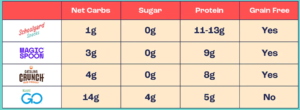
Who is behind the brand
Schoolyard Snacks was started by Helen Guo and Dylan Kaplan. According to their profile in Forbes 30 under 30, the Georgetown University graduates struggled to find no-sugar added snacks, so they decided to create their own.
In March 2019, they launched Schoolyard Snacks from their apartment. Since the launch, more than 200,000 customers have bought snacks through their website, and they’ve sold-out roughly 10 times.
The company has raised $5M in Series A from investment firm Lyra Growth Partners.
As of now, the company is made up of roughly ~12 people, with marketing efforts led by co-founder Helen Guo and partnered with an agency. From the beginning, Helen and Dylan decided they wanted to create a very visual brand that people would naturally share.

Not afraid of the send button
If Magic Spoon’s marketing strategy is light on email and heavy on influencers, Schoolyard Snacks has gone the opposite route.
Schoolyard Snacks leans heavily on email and SMS marketing, aggressively testing new creative concepts in a continual stream of offers, messages, and promotions. It’s best illustrated by walking through my own experience as a new customer.
Co-founder Helen Guo once said in an interview that she thinks one of the big reasons the company has been able to rapidly grow and scale is because they test new creative strategies A LOT. “We’re very relentless about testing. We test maybe 5-10 new creatives on any given day and we’re always coming up with new angles and new ideas.”
To quantify their outreach, over the course of two weeks (June 16th – June 30th) I received a total of 25 emails and 8 text messages from Schoolyard Snacks.
While some people may rush to the unsubscribe button over this level of communication, their tenacious attitude seems to be paying off. Schoolyard Snacks went from zero to 7 figures per month in just one year and made their first $100,000 without spending a dime on advertising (more on that later).
First week
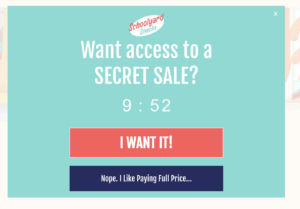
When I first began poking around the Schoolyard Snacks homepage, I was hit with a pop-up asking if I wanted access to a “secret sale” – complete with a 10-minute countdown to create a sense of urgency for new customers who don’t want to miss out at their chance for discounted products.
The sale is very intentionally messaged as a “secret”. Schoolyard Snacks has seen a lot of success with this tactic: It’s meant to make customers feel as if they’re getting an exclusive deal that isn’t available to the general public.
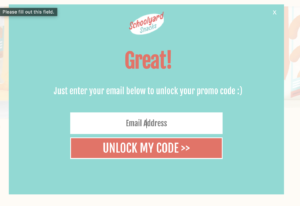
Once I clicked ‘I want it!’ I was taken to what I assumed was the final step in the process: Enter your email address to get the discount code. But wait! There’s more. After I clicked the CTA to unlock my code, I was taken to a final step prompting me to enter my mobile number. Once I hit submit, I was given promo code ‘SECRET’ to use at checkout.
As soon as I entered my email and phone number, I was hit with welcome messages on both. One thing that immediately stuck out to me (and became a theme throughout the campaign) was the personalized and friendly feeling the messages give off. The series of emails I received were sent from co-founder Helen Guo. The style of the emails are written as if she’s casually chatting with a school friend – complete with smiley faces and exclamation points throughout.
The welcome drip series was made up of 5 emails. The first two pushed the 10% off ‘secret code’ while lightly promoting their new products.
The third was a lengthier email where Helen introduces herself and gives her personal backstory for why she founded the company. At the end of the story, she noted that she upgraded me from my original 10% off coupon to 15% off. But I had to act fast! There was only 32 codes available.
When I didn’t take the bait, a 4th and 5th email was sent, each one creating even more urgency for the shopper to use the code before it was gone forever.
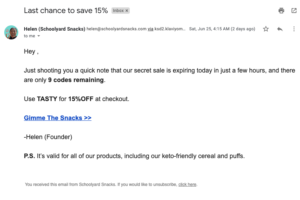
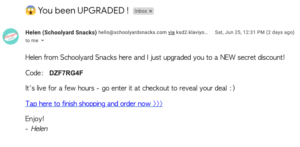
Abandoned Cart
After abandoning my shopping cart, the next round of emails kicked in. This time from co-founder Dylan Kaplan. His email gave a short list of product benefits and ended with my very own secret code for $5 off my purchase. A follow-up email had an entirely new offer: I could get my own sample pack of all 4 cereal flavors for only $12.
I was convinced I had seen every strategy at this point so I moved forward with my purchase: A 24-pack bundle of the two most popular flavors: peanut butter and cocoa.
Purchase
While Schoolyard Snacks is clearly driving users toward signing up for their subscription service (20% off repeat purchases isn’t a bad deal), I opted for the one-time purchase in the name of research. The purchasing process itself was seamless and quick – I leveraged the PayPal plugin so I didn’t even have to reach for my credit card.
Once the purchase was made, I was hit with an enticing offer to make money from promoting their products. Although I’m sure they’re not the only ones doing it, this is the first time I’ve personally ever seen a message like this, written out in this style, post-purchase:
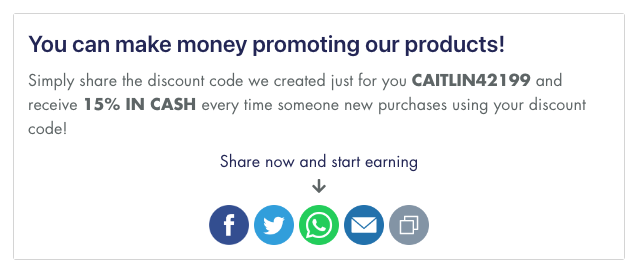
In addition to the offer to become a cereal influencer, I received a thank you email from Guo with a picture of her smiling and waving (the friendly feels continue) along with a few health tips and recipes.
Retention Strategy
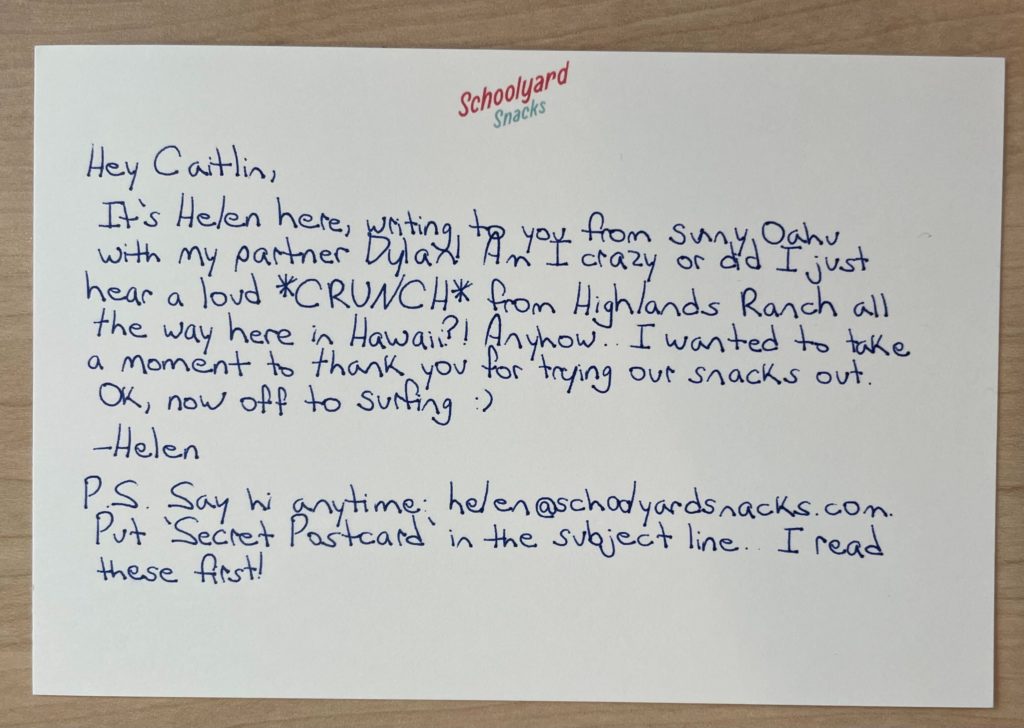
My first ‘post-purchase’ email came from co-founder Dylan Kaplan detailing his personal story of why he chose to start this company (similar to Helen’s welcome email). His story highlighted the fact that they are a small business that cares about its customers.
About a week later, Schoolyard Snacks continued to push the small-town feel by mailing me a customized, handwritten (or at least the appearance of handwritten) note from Guo.
Do they have what it takes?
While I personally think that they could scale back a bit on the number of emails and texts they send, there’s no denying that Schoolyard Snacks is nailing their personalized outreach and they’ve seemed to extend that custom touch into the influencer marketing world. They’ve tapped into a goldmine of free advertising that’s allowed them to drive awareness and rapidly increase revenue without the need for an enterprise marketing budget.
While it may be tough for them to catch up to current DTC cereal leader, Magic Spoon, I don’t think it’s impossible. Why? Schoolyard Snacks excels where Magic Spoon is lacking: personalization and segmentation.

Want to make sure you never miss a Mystery Shopper breakdown? Subscribe.




